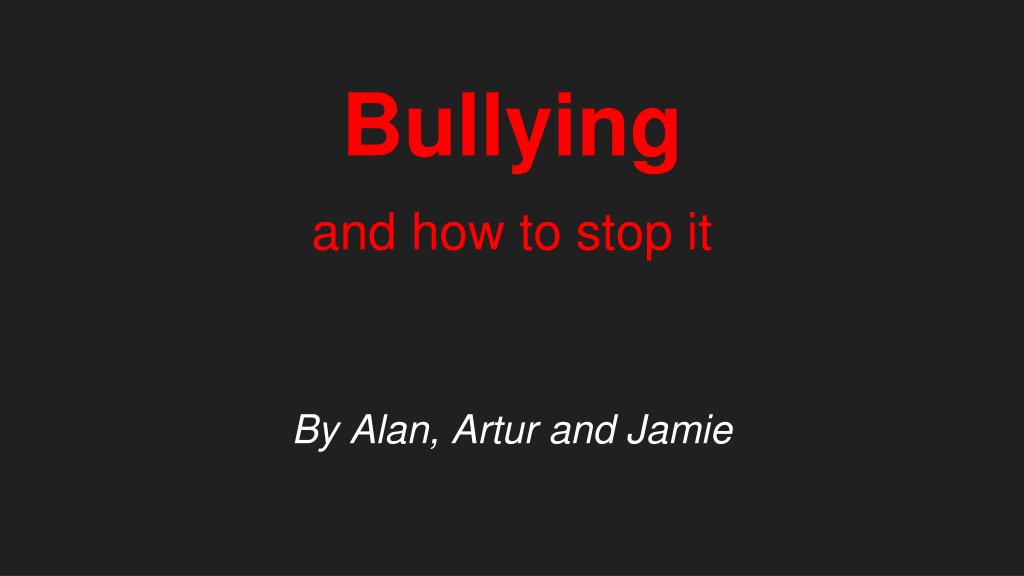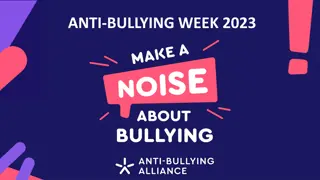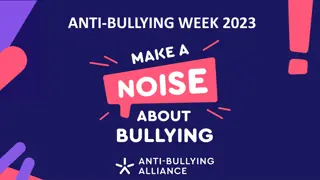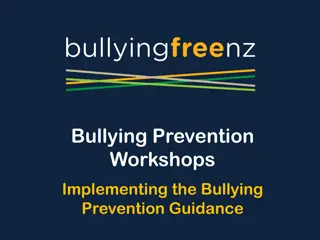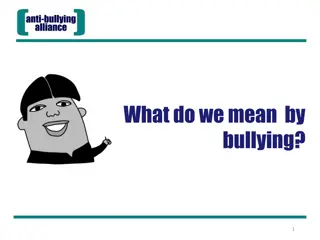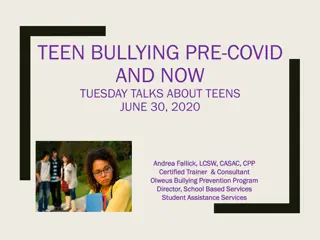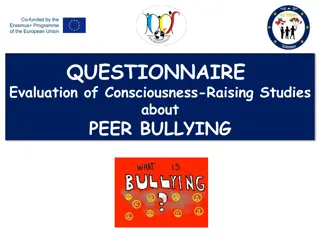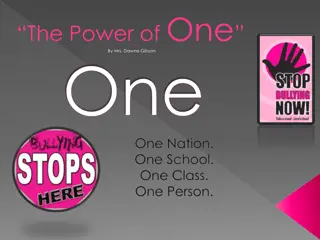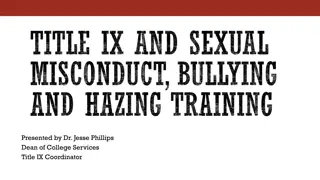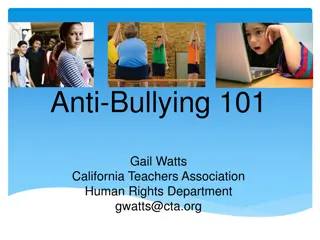Bullying and Ways to Stop It
Bullying is an intentional negative behavior that can have lasting effects on individuals. Learn about different types of bullying, how to spot signs of bullying, and the importance of reporting such incidents. Discover ways to support victims and encourage witnesses to take action against bullying, including cyberbullying. Educate yourself on how to create a safe and inclusive environment for all.
Download Presentation

Please find below an Image/Link to download the presentation.
The content on the website is provided AS IS for your information and personal use only. It may not be sold, licensed, or shared on other websites without obtaining consent from the author.If you encounter any issues during the download, it is possible that the publisher has removed the file from their server.
You are allowed to download the files provided on this website for personal or commercial use, subject to the condition that they are used lawfully. All files are the property of their respective owners.
The content on the website is provided AS IS for your information and personal use only. It may not be sold, licensed, or shared on other websites without obtaining consent from the author.
E N D
Presentation Transcript
Bullying and how to stop it By Alan, Artur and Jamie
What Is Bullying? Bullying is an intentional recurring negative behaviour against a person who can t defend themselves. Types of bullying include: Verbal (Name-calling, insults or humiliation.) Physical (Pushing, shoving, kicking, etc., including damage to property.) Gesture (Threatening gestures such as a throat-slitting gesture.) Exclusion (Excluding or ignoring someone.) Extortion (Forcing another person to give away their property or money.)
How Can I Tell If Someone Is Being Bullied? Bullying can sometimes go unnoticed if you have not been made aware of it. Many students do not tell someone that they are being bullied. This is an issue. In fact, around 65% of people who are bullied don t tell an adult about it. This means that we need to learn to spot the signs of bullying. 65%
How Can I Tell If Someone Is Being Bullied? Some signs that a person is being bullied include: Victims may not want to say what is wrong. Unexplained bruising and cuts. Damage to property. Excuses for not wanting to attend school. Lowered confidence/self-esteem. Difficulty sleeping. Some of these signs can be noticed in a child s behaviour as a result of any type of bullying.
How Can I Report Bullying? You can report bullying in a ton of ways, but the most effective way is to seek help from an adult you trust. This could be a teacher, school staff, parents or an older sibling. The most important part is to ask for help, because when you report bullying, you not only help the person being targeted, but also the person who is bullying.
Witnesses A witness is anyone who sees bullying when it happens. Witnesses often don t try to help because: They may be concerned for their own safety. Don t know what they should do to help. Afraid that they may be picked on. Might be friends with the person/people who are bullying.
About Cyberbullying Cyberbullying is an intentional recurring negative behaviour against a person who can t defend themselves using electronic devices and the Internet. Cyberbullying can be considered as different to bullying. Cyberbullying can become a 24/7 offense, and the bully can hide their identities using anonymity to attack known victims. Some of the ways that people can be cyberbullied are: Exclusion (Telling someone that they aren t invited to a party, etc.) Doxxing (Revealing personal information to the public.) Harassment (Sending hurtful, severe and persistent messages to someone.) Phishing (Stealing the victim s financial information.) Impersonation (Impersonating the victim to make them look bad.)
How To Stop Cyberbullying Stopping cyberbullying might seem like an overwhelming task at first. It is always recommended to inform an adult you trust if you are being cyberbullied or suspect that somebody you know is being cyberbullied. Report harmful messages to the social network or content moderators. Block people who bully online and encourage victims to do the same. Look for help from an adult or teacher. Here s some tips to be safe on the Internet. Do not accept friend requests from people you do not know. Do not give your home address, mobile number, email address, the school you go to to the public. Don t say anything on the internet if you wouldn t say it in a crowded room. If you are using social networking sites, remember to never give out personal information or photos; instead use a nickname. Do not open files from people you don t know.
The End By: Alan, Artur and Jamie 6th Class Scoil Bhride Shantalla
